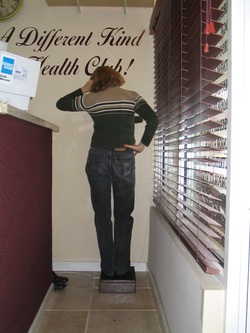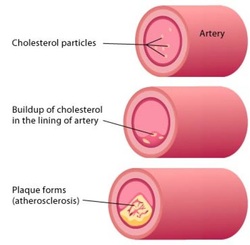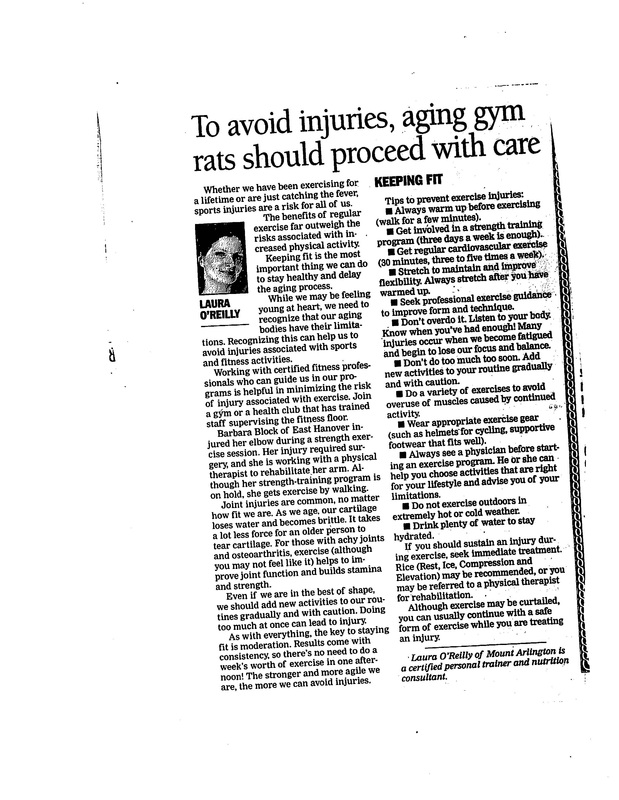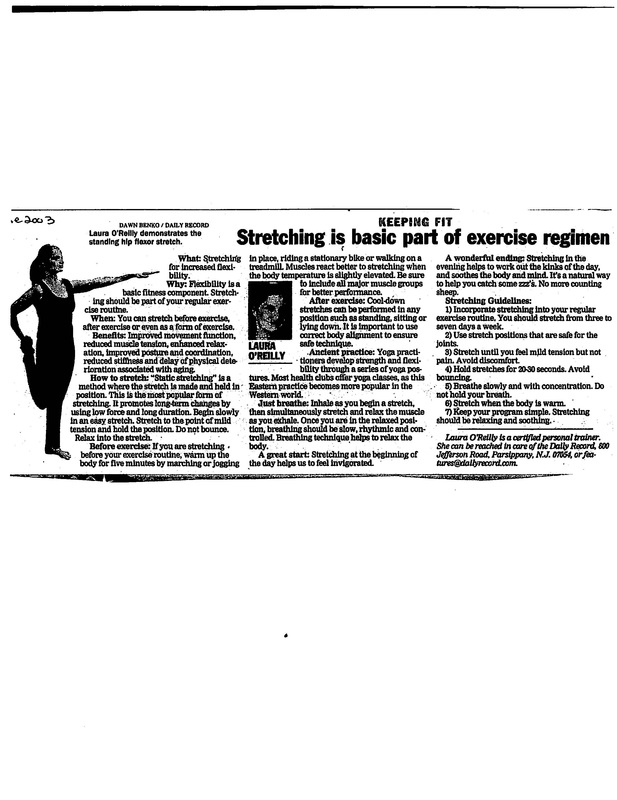Scroll down for tips on exercise, nutrition, weight management, and maintaining good health.
EXERCISE TIP: Strength training is for people of all ages. Strong muscles equal strong bones! Pictured here: Lat Pulls for strong arm and back muscles

With Trainer Michael Bronco at Bronco's Gym in Madison, NJ
Make the connection between your mind and your muscles and get a better quality workout!
Apply your energy to the area of your body you are working to maximize your strength training.
EXERCISE TIP: Get cardiovascular exercise for a fit body and a healthy heart
Running, brisk walking, stair climbing, cycling, and dance classes all have one thing in common. They are aerobic (cardiovascular) exercises which involve large muscle groups working together for a prolonged period of time, increasing the body's demand for oxygen. Simply put, the more blood your heart is capable of pumping in a single beat, the more efficient the heart is, and the stronger it is as a muscle!
People of all ages, shapes, and sizes can improve their health from cardiovascular exercise. Choose an activity that you enjoy- do it alone or do it with a friend. Some people find group exercise motivating. Three to five times a week for 20-60 minutes will do it. If you are a beginner, start for five minutes for the first week, build up to ten minutes the following week and gradually increase your time and speed until you have worked up to 30 minutes. It's refreshing and invigorating, and it burns calories to help manage your weight.
Always check with a physician before starting any exercise program.
EXERCISE TIP: Strong abdominals help overall fitness
Strong abs will help stabilize the body and protect the lower back
During our exercise routines we rely on the abs to stabilize the body and protect the lower back. For this reason it is best to save abdominal exercises for the end, to avoid fatiguing them.
Outside of your workout routine, abdominal exercises can be done at any time throughout the day. They are not muscles that normally get used (like the legs, arms, and buttocks); therefore doing some form of abdominal exercise every day keeps the muscles strong.
A slimmer waistline comes from a total body workout, not just abdominal exercises. For sculpted and defined abs, it is important to lose the body fat that covers them by eating a healthy low fat diet, and doing cardiovascular exercise such as jogging, walking or bicycling.
There are a variety of effective ab exercises to choose from. Some isolate parts of the abdominal region to strengthen the upper and lower portion. The abdominals are one muscle group and can be effectively worked as a whole with a basic crunch.-
Strong abdominals can be developed with isometric exercises during the course of the day. By keeping the muscles pulled in while we walk, sit at our desks, or drive in our cars, we strengthen them and improve your posture.
Fort detailed instructions on how to do abdominal exercises read the sction THE LOW DOWN: A strong core ABDOMINALS: Tummy tone
in my book, GET FIT TO GO.
Apply your energy to the area of your body you are working to maximize your strength training.
EXERCISE TIP: Get cardiovascular exercise for a fit body and a healthy heart
Running, brisk walking, stair climbing, cycling, and dance classes all have one thing in common. They are aerobic (cardiovascular) exercises which involve large muscle groups working together for a prolonged period of time, increasing the body's demand for oxygen. Simply put, the more blood your heart is capable of pumping in a single beat, the more efficient the heart is, and the stronger it is as a muscle!
People of all ages, shapes, and sizes can improve their health from cardiovascular exercise. Choose an activity that you enjoy- do it alone or do it with a friend. Some people find group exercise motivating. Three to five times a week for 20-60 minutes will do it. If you are a beginner, start for five minutes for the first week, build up to ten minutes the following week and gradually increase your time and speed until you have worked up to 30 minutes. It's refreshing and invigorating, and it burns calories to help manage your weight.
Always check with a physician before starting any exercise program.
EXERCISE TIP: Strong abdominals help overall fitness
Strong abs will help stabilize the body and protect the lower back
During our exercise routines we rely on the abs to stabilize the body and protect the lower back. For this reason it is best to save abdominal exercises for the end, to avoid fatiguing them.
Outside of your workout routine, abdominal exercises can be done at any time throughout the day. They are not muscles that normally get used (like the legs, arms, and buttocks); therefore doing some form of abdominal exercise every day keeps the muscles strong.
A slimmer waistline comes from a total body workout, not just abdominal exercises. For sculpted and defined abs, it is important to lose the body fat that covers them by eating a healthy low fat diet, and doing cardiovascular exercise such as jogging, walking or bicycling.
There are a variety of effective ab exercises to choose from. Some isolate parts of the abdominal region to strengthen the upper and lower portion. The abdominals are one muscle group and can be effectively worked as a whole with a basic crunch.-
Strong abdominals can be developed with isometric exercises during the course of the day. By keeping the muscles pulled in while we walk, sit at our desks, or drive in our cars, we strengthen them and improve your posture.
Fort detailed instructions on how to do abdominal exercises read the sction THE LOW DOWN: A strong core ABDOMINALS: Tummy tone
in my book, GET FIT TO GO.
NUTRITION TIP:

Fruits and Veggies are Sensible and Satisfying Snacks
Eating healthy snacks between meals helps to maintain energy levels and prevent bingeing when we become hungry. When your stomach begins to talk to you, hold off on heading to the nearest vending machine for a sweet or salty processed snack. Instead, eat a low calorie piece of fruit or raw veggies to control hunger and provide the body with nutrition and
hydration.
Since skins of many fruits and vegetables such as carrots, potatoes, apples, plums and more, contain nutrients you may not want to peel them. Make sure to scrub away dirt and pesticides, as well as contaminants that could have been transferred during handling. Wash them well with apple cider vinegar diluted in drinkable water. Using soap and detergents to wash produce is NOT recommended.
WEIGHT MANAGEMENT: Do not be a slave to your scale:

Weigh in 2-4 times a month in your underwear in the morning before you have eaten. Weight fluctuates slightly depending on the time of the month, if you are a woman, and other factors. How do you feel? How do your clothes fit? Get regular moderate amounts of exercise on a daily basis to keep unwanted pounds from creeping on. Ask your physician what your Body Mass Index is and learn the healthy weight range based on your height and frame.
Cutting corners to manage your weight

One Less Egg To Fry (Excerpt from Laura O'Reilly's book, "Get Fit To Go".) Copyright 2010
Take a look at the foods in your diet. Are you eating 3 eggs? Eat two. Frying?
Try poaching or grilling. Buttering your bagels? Try low fat cream cheese or fresh fruit spread. Use low fat milk in your coffee and try to eliminate, or at least cut down on table sugar. Be aware of your calorie consumption and find ways to cut corners. These little changes add up to less calories consumed daily. You can lose weight just by making adjustments in the diet and increasing your physical activity. There is no starvation in this strategy, just sensible eating.
Take a look at the foods in your diet. Are you eating 3 eggs? Eat two. Frying?
Try poaching or grilling. Buttering your bagels? Try low fat cream cheese or fresh fruit spread. Use low fat milk in your coffee and try to eliminate, or at least cut down on table sugar. Be aware of your calorie consumption and find ways to cut corners. These little changes add up to less calories consumed daily. You can lose weight just by making adjustments in the diet and increasing your physical activity. There is no starvation in this strategy, just sensible eating.
Dietary Tips to Reduce Your Cholesterol

Having high cholesterol increases your risk of heart disease, heart attacks and stroke. Dietary changes can help reduce cholesterol, keep you off cholesterol-lowering medications or enhance the effects of your medications.
ü Choose healthy fats.
Saturated fats, found in red meat and dairy products, raise your total cholesterol as well as your LDL cholesterol (low density lipoprotein). LDL is the “bad” cholesterol. HDL (high density lipoprotein) is the ‘good’ cholesterol. Choose lean cuts of meat, low-fat dairy and monounsaturated fats. Avoid trans fats by staying away from foods containing partially hydrogenated oil.
ü Eat whole grains.
A variety of nutrients found in whole grains promote heart health. Eat breads and pasta made from whole grains, use whole-wheat flour and choose brown rice over white rice.
ü Fresh fruits and vegetables are rich in dietary fiber, which can help lower cholesterol.
ü Consume foods rich in omega-3 fatty acids.
Omega-3 fatty acids can help lower your “bad” cholesterol. Fish – such as
salmon, mackerel and herring, contain omega-3 fatty acids. Some other sources of
omega-3 fatty acids are walnuts, almonds and ground flaxseeds.
A fitness regimen along with a healthy diet helps to manage your cholesterol and keep your heart healthy.
Always consult a physician about diet and exercise and before making changes to your medication.
ü Choose healthy fats.
Saturated fats, found in red meat and dairy products, raise your total cholesterol as well as your LDL cholesterol (low density lipoprotein). LDL is the “bad” cholesterol. HDL (high density lipoprotein) is the ‘good’ cholesterol. Choose lean cuts of meat, low-fat dairy and monounsaturated fats. Avoid trans fats by staying away from foods containing partially hydrogenated oil.
ü Eat whole grains.
A variety of nutrients found in whole grains promote heart health. Eat breads and pasta made from whole grains, use whole-wheat flour and choose brown rice over white rice.
ü Fresh fruits and vegetables are rich in dietary fiber, which can help lower cholesterol.
ü Consume foods rich in omega-3 fatty acids.
Omega-3 fatty acids can help lower your “bad” cholesterol. Fish – such as
salmon, mackerel and herring, contain omega-3 fatty acids. Some other sources of
omega-3 fatty acids are walnuts, almonds and ground flaxseeds.
A fitness regimen along with a healthy diet helps to manage your cholesterol and keep your heart healthy.
Always consult a physician about diet and exercise and before making changes to your medication.




